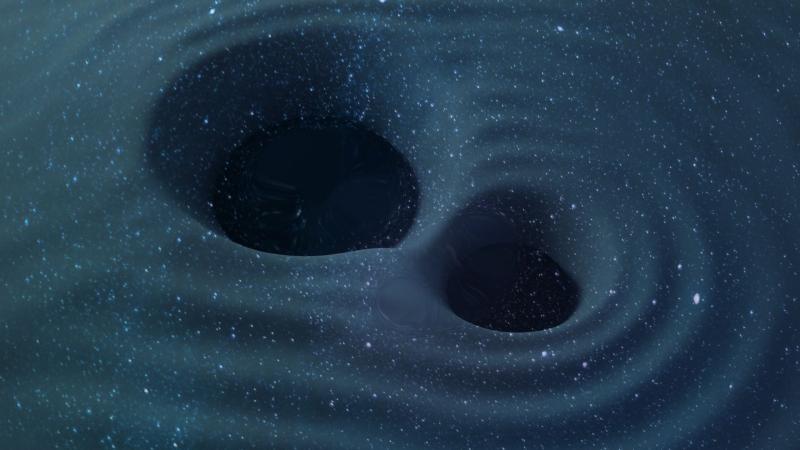
In an extraordinary finding of stellar astrophysics, the LIGO (The Laser Interferometer Gravitational-Wave Observatory)-Virgo-KAGRA (LVK) Collaboration, which includes researchers from India, has announced the confident detection of GW231123, the most massive binary black hole (BBH) merger ever observed with high statistical significance. The gravitational wave (GW) signal captured on 2023 November 23 revealed a powerful collision between 2 blackholes with a total mass between 190 and 265 times that of our sun, culminating in the birth of a massive black hole remnant.
Did You Know? Black holes come in different sizes: stellar-mass black holes, which are 5 to 100 times the mass of the Sun; supermassive black holes, millions or billions of times the Sun's mass, found at the centres of galaxies; and the elusive Intermediate-Mass, hundreds to hundreds of thousands of times the Sun's mass. |
The short-duration signal, lasting only about 0.1 seconds, was detected simultaneously by both the Advanced LIGO Hanford and Livingston detectors, confirming the event's transient nature. The combination of coherent detections from the two observatories was crucial, preventing the signal, which had a high network signal-to-noise ratio (SNR) of around 20.7, from being dismissed as a terrestrial artefact or glitch.
The record-breaking event poses a challenge to the standard model of stellar formation, which spans our current understanding of how stars and black holes form. The findings directly challenge a long-standing theoretical prediction, the Pair-Instability (PI) Mass Gap. The PI Mass Gap is part of the standard model of stellar formation, which predicts that stars anywhere between 50 and 130 times our sun’s mass cannot form blackholes due to pair instability.
The Pair-Instability Mass Gap
When a star runs out of fuel, gravity usually wins, leading to a core collapse that, for average massive stars, creates a supernova explosion and leaves behind a black hole. However, for a specific range of truly colossal stars, a quantum-mechanical event called Pair-Instability (PI) kicks in. But in stars 60 and 130 times the mass of our Sun, as the star begins to collapse at the end of its life, the high-energy light particles or photons become so energetic that they spontaneously trigger a phenomenon called pair production, where pairs of matter and antimatter, specifically, an electron and its antimatter twin, a positron, are produced.
This transformation causes the outward pressure holding the star up to suddenly plummet, triggering an explosive burst of fusion so powerful it tears the star apart. This process effectively creates the PI Mass Gap of black holes formed from single stars, which is a theoretically empty region in the black hole mass chart.
However, the analysis of GW231123 reveals component masses that fall within this forbidden zone, with 130 solar masses for the primary black hole and 101 solar masses for the secondary black hole. This strongly implies that at least one of the component black holes, and possibly both, either formed in a way that bypasses the PI supernova mechanism or they grew quickly from a smaller mass.
Further adding to the event’s intrigue, the analysis revealed that both component black holes were spinning rapidly, with spin magnitudes of approximately 0.90 and 0.80, among the highest confidently measured black hole spins observed in gravitational wave events. This high-spin, high-mass combination is difficult to explain with standard stellar evolution models, which typically predict low or misaligned spins. Instead, the inferred properties point toward different formation mechanisms, such as accretion in a gaseous environment or hierarchical mergers, in which the components are the products of even earlier black hole mergers. Hierarchical mergers are thought to happen in extremely dense environments like young star clusters, globular clusters, or the disk of an Active Galactic Nucleus (AGN). They also naturally produce the massive, rapidly spinning black holes observed in GW231123, confirming a vital pathway for creating Intermediate-Mass Black Holes (IMBHs) with masses around 200 solar masses.
The observation of GW231123 pushes the boundaries of our understanding of the universe. By challenging fundamental theories of stellar evolution and confirming a pathway for the formation of intermediate-mass black holes, the experimental evidence helps researchers paint a more complete picture of cosmic history and the laws of physics that govern the most extreme objects in existence. Future observing runs are expected to detect a greater number of such signals, helping resolve remaining uncertainties and providing a clearer understanding of the birth and growth of these cosmic giants.
This article was written with the help of generative AI and edited by an editor at Research Matters.